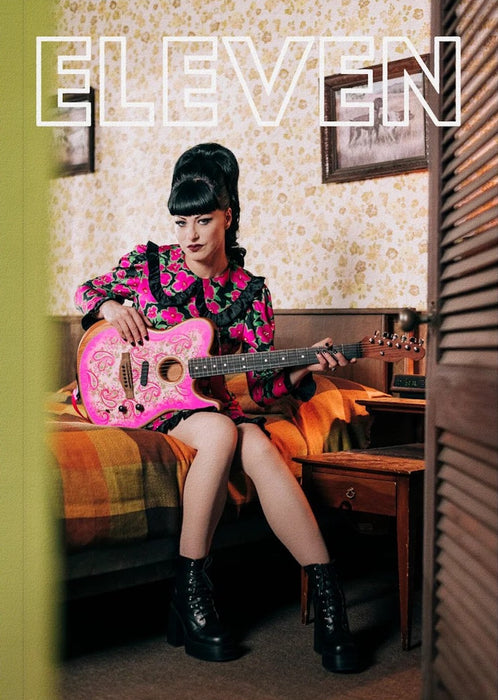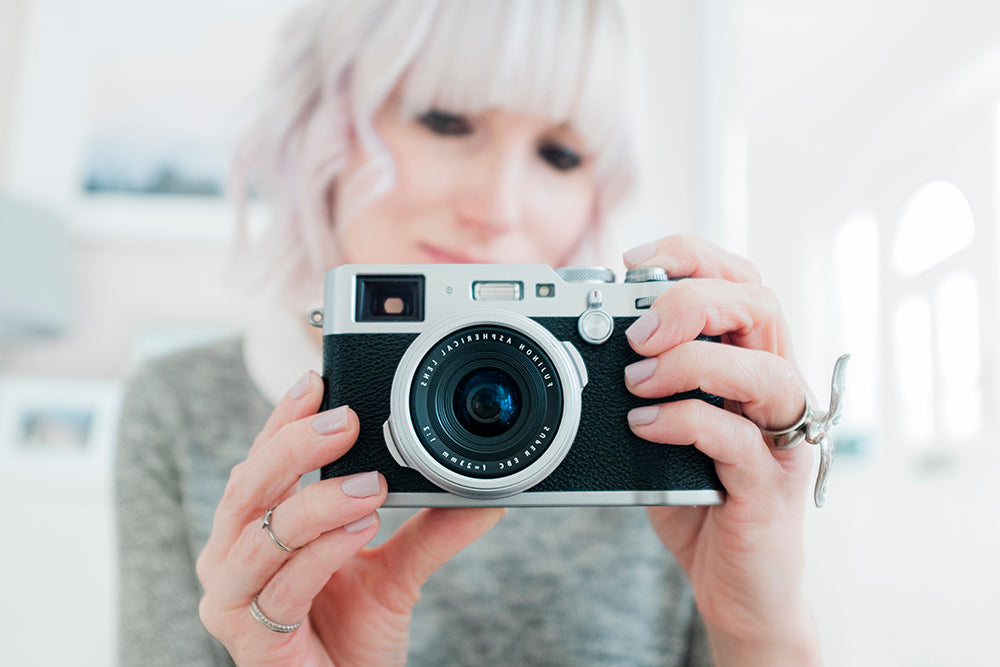

Eleanor Jane, Eleven
Named after ‘Spinal Tap’s famous exhortation to ‘Put it up to eleven’, British magazine Eleven uses the guitar as a springboard for themes of music, creativity and storytelling.
Founder Eleanor Jane is a photographer in the music industry who launched her magazine in frustration at the lack of adventure in traditional music magazines. With issue two of Eleven now in shops, she explains more about its origins as she shares her week. And yes, she does play guitar, ‘I’ve played badly for over 20 years and never much improved…’
What are you doing this Monday morning?
First and foremost, I’m drinking tea and eating porridge at my desk while I check emails. Then I’m packaging up the direct orders that came in over the weekend and dropping them off at the post office. After years of holding up the queue with my projects, the post office staff and I have finally come to an understanding—I drop everything off and they deal with it throughout the day.
I spend the time I’m not waiting in that queue doing a quick lap around the Victorian cemetery next to my house. Late morning I have a call with a client in Greece to discuss a creepy little set I’m building for a photoshoot, then it’s time to do some prep for an upcoming trip to New York. I’m always juggling multiple projects and ideas. At some point today, I plan to have a flick through the astronaut Chris Hadfield’s book ‘An Astronaut's Guide to Life on Earth’ (aka, the astronaut who performed Space Oddity on the International Space Station). I dreamt I was floating around the station trying to interview him for Eleven, so I need going to make sure I'm ready incase that becomes a reality…

Describe your work environment.
I work from home and am lucky to have a very cheerful office all to myself. It’s flooded with natural light—especially in the morning. If I'’m being very good, I like to do a bit of yoga on the rug in front of my desk while the sunlight is still falling on it. My cat Salem sleeps on the window behind the blinds and often her little tail pokes through the slats. The space is filled with all of my favourite things, including mementos from my travels, but I keep it super neat and organised.
Work can be so chaotic—the music industry is a world of endless cables and wires—or I’m living out of the corner of a suitcase mostly rammed with camera equipment, so when I get home I like everything to be calm.

Which magazine do you first remember?
I think Bunty—it was a much more innocent time! I would also read old annuals from the 60s and 70s girls’ magazines that belonged to my mum and aunties. When I was probably far too young, I used to read my nan’s Take A Break magazine which felt like a real guilty pleasure with its lurid stories. I moved on to teen magazines in the 90s and my absolute favourites were the ones with the photo-story comics, usually tales of boy drama featuring stroppy teenagers wearing scrunchies and shell suits! I loved those and used to try to recreate them with my 35mm compact camera.

Eventually music crept into my life and I would get Kerrang, NME, and Melody Maker before discovering Dazed, i-D and The Face when I went to college. In university we went on a gallery trip to London which included a stop off at Magma and that’s when my love for independent publishing began. I can’t remember anything about the exhibitions we went to see, all I remember is blitzing my money on the most beautiful magazines and how heavy they were as I dragged them around for the rest of the day. I still remember what I bought—Amelia’s Magazine and this amazing Mexican magazine called Baby Baby Baby which was printed on recycled paper and had a much more cut and paste, zine aesthetic. I was obsessed with it.
Magazines were really good around that time—Lula, Nylon, Frankie, POP. I got hugely into the zine scene. For a few years, I created a series of full colour perzines (‘per’ meaning personal) and would table them at symposiums. I made all sorts of lovely friends and penpals through that world, it was such a great community.

Which magazine matters to you the most this morning?
There was a fantastic mag called Guitar Magazine which ran for 30 years and sadly closed in 2021 after a change of ownership. That magazine was so much fun. I worked on it with my partner and through that mag I made so many friends, went on great adventures, and we worked so hard. I made fantastic connections that helped shape my career.

Describe Eleven in three words
Expensive to post.

You’ve been successful as a music photographer, what led you to launch your own magazine?
Over the past 15 years I have photographed for mainstream guitar magazines all over the world. I started off photographing portraits, behind-the-scenes rig tours, and a lot of iconic instruments. I was always amazed at the doors guitars would open and the interesting people I would meet, the stories they would share. It was inspiring, endless fuel for creativity, and one job or contact always lead to another.
I’m a highly motivated and busy person, but traditional magazines began to get frustrating—they weren’t all that adventurous in the types of stories they were interested in telling. There are so many unique and creative artists in all corners of the guitar world that are overlooked because they aren’t spending ad money. I have an insatiable curiosity to seek out and meet these people. I wanted to lift them up while having fun with the photography and creating features that anyone could enjoy. The name is a nod to Spinal Tap and every issue has eleven features, because it’s useful to have some sort of framework!

It’s a mix of (but not exclusively) guitars, women and storytelling. How do you balance these three points?
I think there’s been a misunderstanding that Eleven is a guitar magazine for women. I was showcasing the magazine at The Guitar Show recently and that seemed to be the general assumption. But it isn’t. It just happens to be female-owned and the current issue has a woman on the cover. When people see a guitar magazine and Slash is on the cover, they don’t assume it’s for men. But women are so underrepresented in the guitar world that when you do make the point that it is a positive space for women, I suppose it automatically seems like a specialist title. Eleven is for everyone but I hope that approaching things from a female perspective means it’s inclusive and diverse by default.

The magazine contains a few guitar-orientated adverts. What advice can you offer other publishers on getting ads?
All of the ads in Eleven are from companies that I have some sort of prior relationship with. Advice? Meet as many people as you can in your industry, be present, be visible, and be genuinely interested in people and their stories.

Please highlight one story from the new issue that sums up what you’re trying to do with the magazine.
In ‘A Walk in The Marshes’ I take a winter ramble along the River Lea in conversation with folk musician and actor Johnny Flynn and celebrated author Robert Macfarlane. We discuss creativity, collaboration, and the art of the story. I don't think we even mentioned Johnny’s guitar-playing in the interview, it was just a wonderful and generous conversation that I hope inspires others as much as it did me.
My favourite features in Eleven so far have only tenuously been linked to the guitar. In fact, the story that first sparked my imagination and propelled me through the journey of creating Eleven in the first place is the survival story of Moss Hills, as told in issue one. He’s a cruise ship musician who saved over 500 passengers when the liner on which he was performing began to sink off the coast of South Africa, only for the captain and crew to abandon ship.
What one piece of advice do you have for someone producing their own magazine?
As with any piece of art, make it for yourself first.
What are you most looking forward to this coming week?
It’s hard to take any time off when you run your own business and your work is all-consuming, but I’m looking forward to four days of enforced downtime over the Easter weekend with my partner, pottering about in the garden and going on walks. But once you get out there in the wind and the sun and start moving, that’s when the creative ideas come, so you can never truly turn off!
Design Philip Millard
Buy your copy from the magCulture Shop



